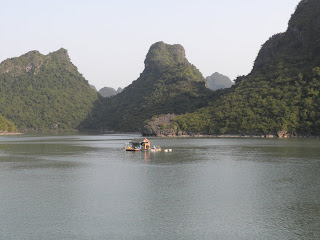From Siem Reap, we flew to Phnom Penh, Cambodia's capital city, but unfortunately we only had a little more than 1 day there before our next flight. We did get to see a good bit of the city though, and some of the main sights to see.
In the morning, we went to the Killing Fields, several kilometers outside of the city. This relates to a complex story in Cambodia's not so distant past. Essentially there was the Khmer Rouge regime in Cambodia from about 1975 until 1978, during which genocide took place and thousands of Cambodians were killed. Because the regime prioritized poor, uneducated farmers, the largest majority of those killed were educated and from the city centers.
The Killing Fields is a shocking sight to see, even in comparison to places like Auschwitz. While thousands of bodies have been exhumed from the dozens of mass graves there, nearly everywhere you look between the large holes in the ground, you can see bones and pieces of clothing sticking out of the ground. We paid for a guide at the site, who told us that both of his parents had been killed there. He showed us around, and while explaining the story, would frequently point to the ground at a tooth here or piece of bone there.
There is also a structure built there to house most of the bones collected there. As you can see in many of the skulls, the victims were frequently bludgeoned to death instead of shot, in order to save expensive bullets.

Les champs d'execution juste en dehors de Phnom Penh ou s'est perpetre un genocide de 1975 a 1978 par le regime des Khmer rouge.
Des milliers de personnes ont ete tues dans tous le pays.
En deterrant les fosses communes, on s'est rendu compte de l'horreur qui s'est passe... Pour sauver des balles, les executions se faisait a coup de hache, pelle, et autres outils...

Many of the skulls were missing their front teeth. Our guide told us that the front teeth were frequently pulled out as torture before the person was killed.
Un mausolee se dresse au centre des champs d'execution, ou sont disposes les os des victimes.
On peut remarquer que les cranes n'ont plus beaucoup de dents, elles ont ete retirer lors de torture precedent l'execution.

Some miscellaneous pieces of bone stuck in the ground.
Des morceaux d'os recouvrent le sol...

Clothing partially buried.
Des restes de vetement encore enterres, toutes les fosses communes n'ont pas ete ouvertes.

Here is a tooth.
De nombreuses dents se trouve sur le sol, ainsi que des os de nouveaux nes, femmes, enfants...
Following the depressing Killing Fields, we went to S-21, a former high school in Phnom Penh that was converted to a prison during the Khmer Rouge regime. Most rooms in the prison are sparse, usually only containing a metal bed frame and a black and white picture on the wall, depicting a tortured victim, chained to the bed frame. Some of the rooms have small cells built into them, and others have hundreds of pictures, mugshots of the prisoners. Most of the prisoners there either died in the prison or were taken to the killing fields to be executed.

S-21, un lycee au centre de Phnom Penh reconvertis en prison/salles de torture sous le regime de PolPot. C'est la que les prisonnier etait entreposes avant d'etre amener au champs d'execution.



Pictures of the prisoners showed the vast age range.

On a lighter note, here's a typical gas station that you see frequently in SE Asia. It's really just a stack of bottles (usually old Pepsi or Sprite bottles) filled with gasoline. Someone will pull up in their scooter, and the attendant will use a funnel to pour some gas into their tank.


















































